
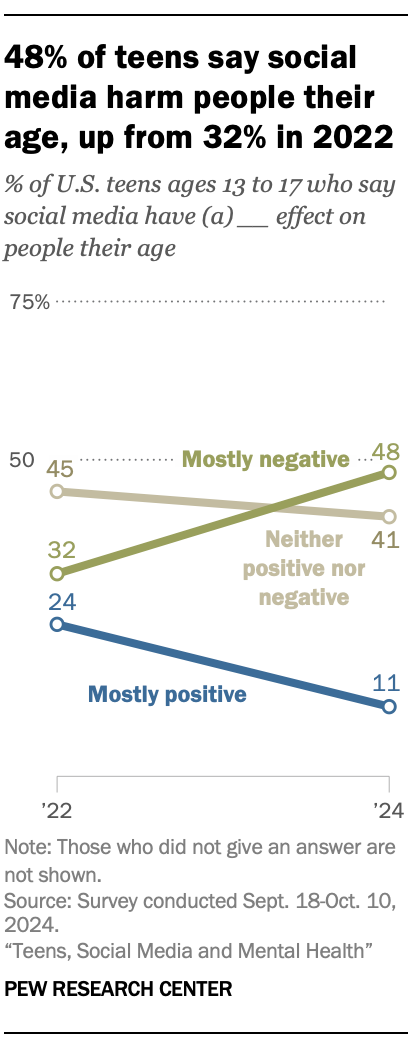
Rising rates of poor mental health among youth have been called a national crisis. While this is often linked to factors like the COVID-19 pandemic or poverty, some officials, like former Surgeon General Vivek Murthy, name social media as a major threat to teenagers.
Our latest survey of U.S. teens ages 13 to 17 and their parents finds that parents are generally more worried than their children about the mental health of teenagers today.
And while both groups call out social media’s impact on young people’s well-being, parents are more likely to make this connection.1
Still, teens are growing more wary of social media for their peers. Roughly half of teens (48%) say these sites have a mostly negative effect on people their age, up from 32% in 2022. But fewer (14%) think they negatively affect them personally.
Other key findings from the survey:
- More teens report spending too much time on social media: 45% of teens say they spend too much time on social media in our current survey, up from 36% in 2022.
- Girls’ experiences on social media skew more negative, at times: Teen girls are more likely than boys to say social media hurt their mental health (25% vs. 14%), confidence (20% vs. 10%) or sleep (50% vs. 40%).
- A majority of teens see social media as a positive space for friendships and creativity: 74% of teens say these platforms make them feel more connected to their friends, and 63% say they give them a place to show off their creative side.
- Teens and parents have different comfort levels talking about teen mental health: 80% of parents say they’re extremely or very comfortable talking to their teen about their teen’s mental health. Smaller shares of teens (52%) feel the same way.
- Social media as a mental health resource: 34% of teens say they at least sometimes get information about mental health on social media.
Jump to read about views among parents and teens on: Mental health concerns | Openness to talking about mental health with others
Jump to read about views among teens on: Social media as a mental health resource | Social media’s effect on teens | Feelings about social media in their own lives | Screen time
Parents’ and teens’ concerns about mental health

To better understand how families are grappling with issues related to youth mental health, we asked teens and parents to share their level of concern, thoughts on underlying causes, and openness to discussing mental health.
Parents are more likely than teens to be concerned about teen mental health today. Overall, 55% of parents report being extremely or very concerned about the mental health of teens today. Fewer teens (35%) say the same, according to our survey of 1,391 parents and their teens conducted Sept. 18-Oct. 10, 2024.
On the other hand, a larger share of teens than parents say they’re not too or not at all worried about the state of teen mental health (23% vs. 11%).
About this report
There are growing debates about social media’s impact on youth mental health. This survey seeks to surface teens’ and their parents’ perspectives on this topic, not to supply evidence or establish causality.
We used the overarching term “mental health” throughout our survey questions to ask teens and parents about their broad experiences.
Teens’ and parents’ views, by gender
Teens’ concerns about mental health differ by gender. Girls more often than boys say that they are highly concerned about teen mental health (42% vs. 28%).
We also see differences among parents – both based on their gender and the gender of their child.
Mothers are more likely than fathers to say they are extremely or very concerned about the mental state of teens today (61% vs. 47%).
Additionally, parents of a teen girl are more likely than those with a teen boy to express high levels of concern (61% vs. 49%).
Related: The Gender Gap in Teen Experiences
Teens’ and parents’ views, by race and ethnicity
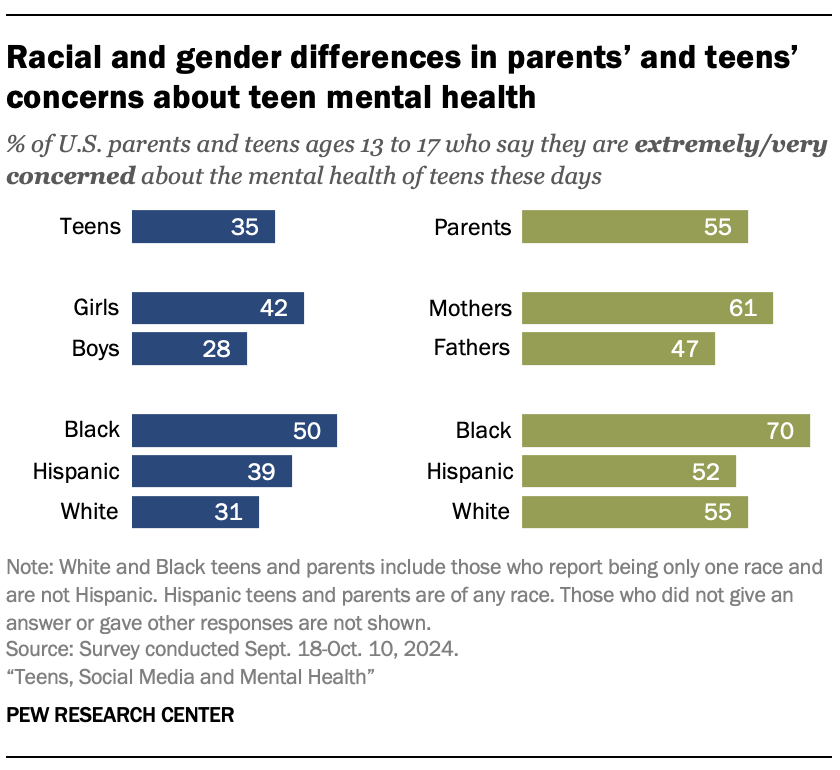
There are also notable differences by race and ethnicity. Seven-in-ten Black parents say they are extremely or very worried about teen mental health. This is higher than the shares seen among White (55%) and Hispanic (52%) parents.2
Black teens also stand out in their concern about teen mental health. Half of Black teens report being highly concerned, compared with 39% of Hispanic teens and an even smaller share of White teens (31%).
What contributes the most to teens’ mental health?
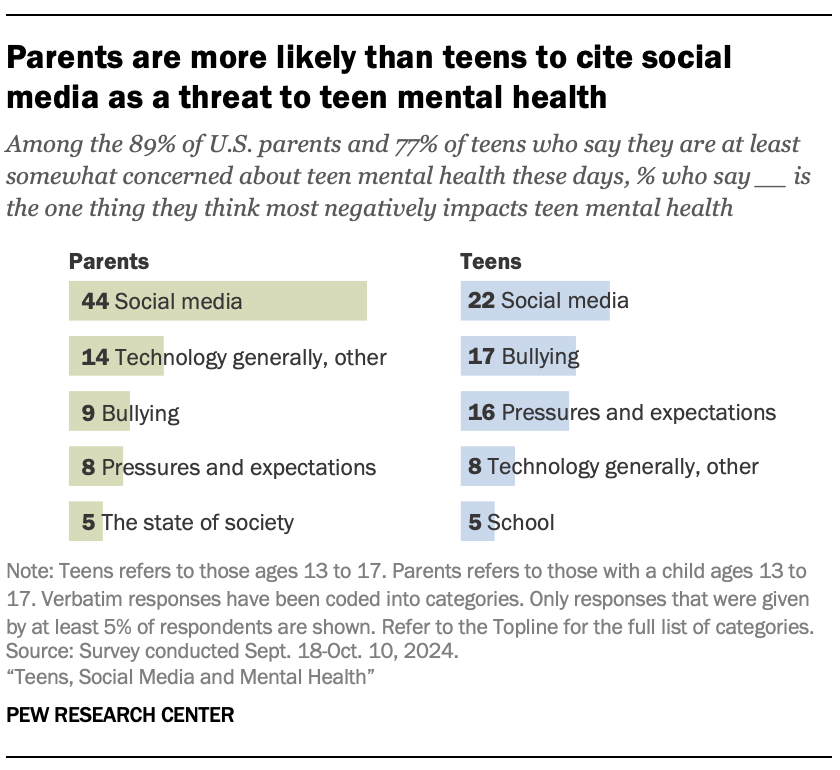
Parents and teens who say they are at least somewhat concerned about teen mental health today were then asked what they think most negatively impacts it.
While both groups cited similar themes, parents more often blame social media, while teens cite a range of factors, including social media, bullying and social pressures.
Views among parents
Social media is the top reason parents give when asked about what most negatively impacts teens. Among parents who are at least somewhat concerned about teen mental health, 44% say social media have the biggest negative impact on teens today.
“They live in a fake world of social media that limits them as human beings, distancing them from their family.” (Translated from Spanish)
– Mother of teen
“Social media is a big part of teens’ lives nowadays, and they are always trying to live up to the expectations of all the friends on their pages.”
– Father of teen
Some of these parents – though far fewer – mention the negative impacts on teens of technology more broadly or name another specific type of technology (14%).
“Technology, which is making them more afraid to try things, makes them less creative and makes them less likely to figure out how to solve their own problems, whether relationally or physically.”
– Mother of teen
And about one-in-ten say online or offline bullying (9%) or the pressures and expectations that teens experience (8%) is the main contributor.
“Kids bullying, making fun of the less fortunate or the kids that aren’t sports-oriented or considered cool.”
– Mother of teen
“[There’s] too much emphasis on the idea that they need to be perfect. In academics, social interactions, appearance, fitness and every conceivable way.”
– Father of teen
Views among teens
Parents often point to social media, but teens cite a broader range of negative influences on youth mental health.
Still, among teens who say they are at least somewhat concerned about the mental health of teens today, 22% cite social media as the main factor.
“The overuse of social media in our society seems to be the main cause of depression among those in my age group. People seem to let themselves be affected by the opinions of people they don’t know, and it wreaks havoc upon people’s states of mind.”
– Teen boy
“The people they see on social media, it makes them think they have to look and be like them or they won’t be liked.”
– Teen girl
Another 8% of these teens point to technology broadly or another type of technology.
About one-in-five teens who are at least somewhat concerned cited bullying – in person or online (17%). And 16% say the pressures and expectations placed on teens today is what most negatively impacts teen mental health.
“Bullying from other students and the ones that want to fit in and be accepted.”
– Teen boy
“Everyone expects teens to have it all figured out by the time we get out of high school. Sometimes we don’t know what we want to do. We are figuring life out too.”
– Teen girl
Comfort levels with discussing mental health
The National Institute of Mental Health highlights the importance of open communication to help teens feel supported. But are parents and teens comfortable having these conversations?
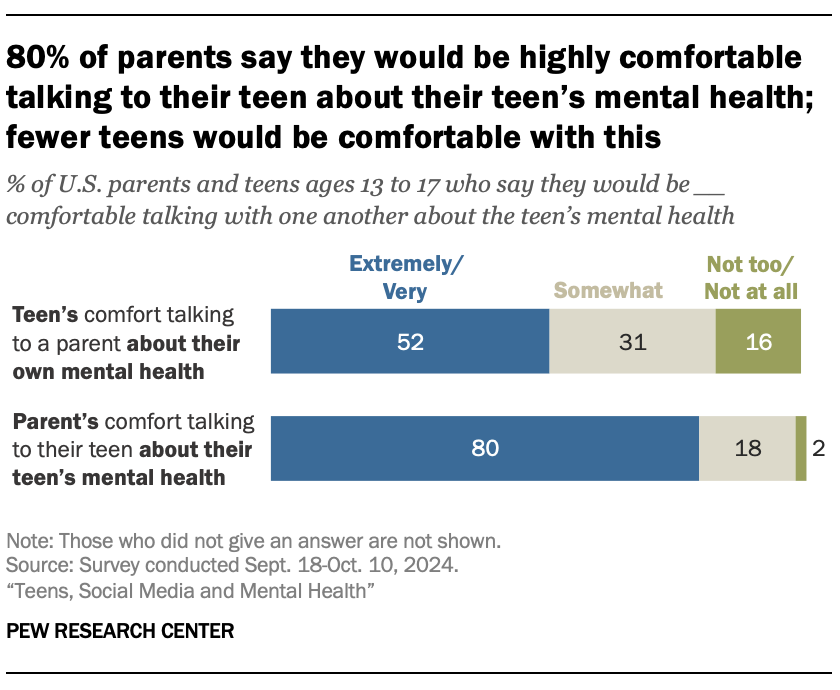
The vast majority of parents are comfortable talking with their teen about their child’s mental health; fewer teens are comfortable doing this. Eight-in-ten parents say they would be extremely or very comfortable doing so, compared with 52% of teens.
Most mothers and fathers say they’d be extremely or very comfortable having these conversations with their teens. However, the share is higher among moms than dads (84% vs. 75%).
Just 2% of parents say they would be not too or not at all comfortable, while this share rises to 16% among teens.
Besides parents, we also asked teens about their comfort levels in discussing their mental health with four other types of people: friends, therapists, family members and teachers. Our survey finds their openness varies widely by who they’re talking to.
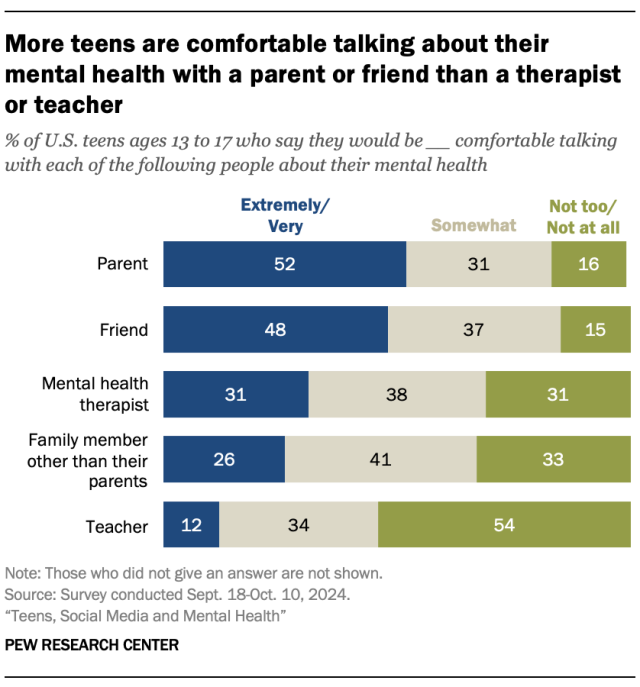
A parent: Roughly half of the teens say they would be extremely or very comfortable talking with a parent about their own mental health.3
A friend: 48% say they’d be highly comfortable talking about their mental health with a friend. This makes parents and friends the top choices for teens when having these discussions.
A therapist or family member: 31% say they would be highly comfortable talking about their mental health with a therapist. And a slightly smaller share (26%) say this about talking with a family member other than their parents.
A teacher: Relatively few teens (12%) say they would be extremely or very comfortable discussing their mental health with a teacher. In fact, 54% say they would not be comfortable with this.
Teens’ views, by gender
Teen girls are more comfortable than boys talking about their mental health with friends. While 58% of teen girls say they are highly comfortable doing this, that share drops to 38% for boys.
Girls are also more likely to say they would have this comfort level with a mental health therapist (34% vs. 27%).
Similar shares of boys and girls say they’d be extremely or very comfortable talking to parents, other family members or teachers about their own mental health.
Teens’ views, by race and ethnicity
There are also racial and ethnic differences in teens’ comfort levels speaking with a therapist or a teacher. Roughly four-in-ten Black teens (41%) say they’d be extremely or very comfortable doing so, compared with smaller shares of Hispanic (31%) and White (28%) teens.
Black (17%) and Hispanic (15%) teens are more likely than White teens (10%) to say they would be highly comfortable talking to a teacher about their mental health.
The share of teens who say they’d be highly comfortable talking about this with friends, parents and other family members varies little by race and ethnicity.
Social media as a mental health resource
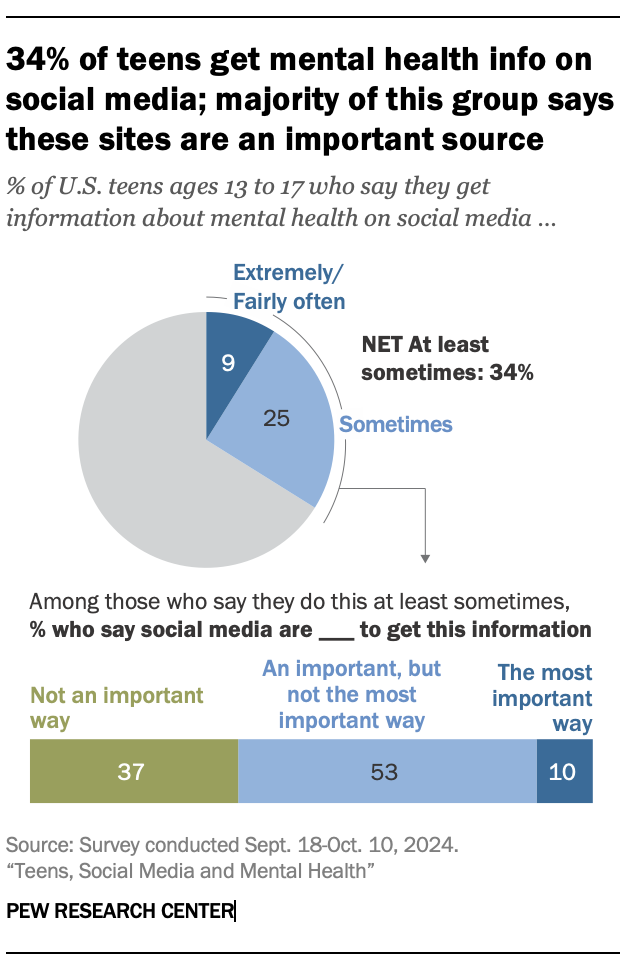
Some teens are also turning to social media to find information about mental health. Platforms like TikTok have become spaces for influencers and therapists alike to share their experiences and advice about mental health.
In our survey, 34% of teens say they at least sometimes get information about mental health on social media. This includes 9% who say they do this extremely or fairly often.
We also asked these teens how important social media platforms are as a resource for mental health information. Among those who do this at least sometimes, 63% say it’s an important way they get information about mental health.
Another 37% of these teens say social media are not an important way they get mental health information.
Teens’ experiences, by gender
Teen girls are more likely than boys to get this information on social media. Four-in-ten girls say they at least sometimes get mental health information on social media, compared with 28% of boys.
However, among those who at least sometimes get mental health information on social media, statistically similar shares of girls (64%) and boys (60%) say it’s an important way they get this information.
Teens’ experiences, by race and ethnicity
Larger shares of Black teens report using social media to get information about mental health. About half of Black teens (49%) say they do this at least sometimes, compared with smaller shares of Hispanic (35%) and White (30%) teens.
Teens’ views of – and experiences on – social media
One area where teens share contrasting views about social media is when discussing its effect on their peers versus their own experiences.
Similar to the last time we asked this question, more teens think social media have a negative effect on people their age than on them personally. About half of teens (48%) say social media platforms have a mostly negative effect on people their age. Meanwhile, 14% see a mostly negative impact for themselves, up slightly from 9% in 2022.

Teens are more than twice as likely to say social media have a positive impact on themselves than on their peers (28% vs. 11%).
Still, the most common response falls into the neutral category. About six-in-ten teens (58%) say the effect on them is neither positive nor negative.
Views of peer impact over time

Teens’ views of the impact of social media on their peers has grown increasingly negative. The share who say these sites have a mostly negative effect on people their age is up 16 percentage points since 2022.
At the same time, the share who believe these platforms have a mostly positive effect on people their age decreased from 24% in 2022 to 11% in our current survey.
The percentage who describe social media’s effect on their peers as neither positive nor negative has remained statistically unchanged over this time span.
How teens see social media’s impact on mental health, friendships, sleep
Teens’ views of the benefits and harms of social media vary by which aspect of their lives you ask about. Still, many believe these platforms don’t have much influence over them.
In our survey, teens are far more likely to say social media hurt rather than help their sleeping habits and productivity, which are both crucial for well-being, according to experts.
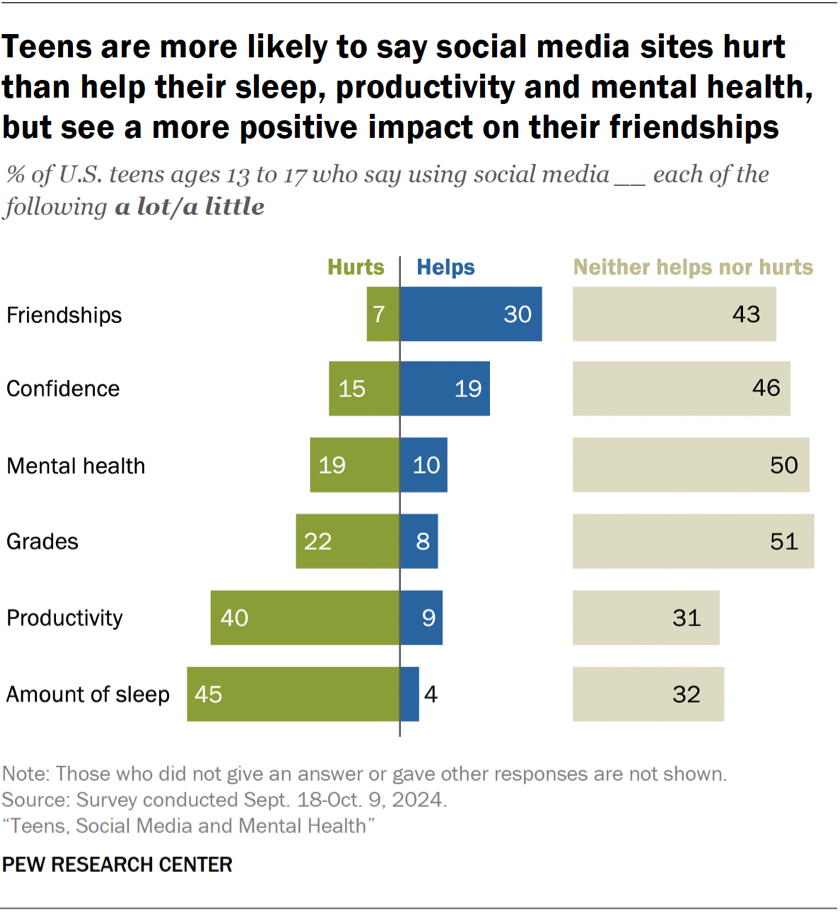
Four-in-ten or more teens say social media platforms hurt the amount of sleep they get (45%), as well as their productivity (40%). Small shares – about one-in-ten or fewer – say social media platforms help with these things. And roughly one-third say these platforms neither help nor hurt.
About one-in-five teens say social media hurt their mental health (19%) or grades (22%). Roughly one-in-ten each say these platforms help. But the largest shares say these platforms have a neutral impact on their mental health (50%) and grades (51%).
Similar shares of teens say social media help (19%) or hurt (15%) their confidence. Still, nearly half (46%) say these platforms neither hurt nor help.
Friendships are the only aspect of teen life that we asked about in which more teens say social media help rather than harm these relationships (30% vs. 7%). Again, a sizable share of teens (43%) describe social media’s impact in neutral terms.
Teens’ experiences, by gender
Similar to our previous surveys, teen girls are generally more likely than boys to report having a more negative experience on social media.
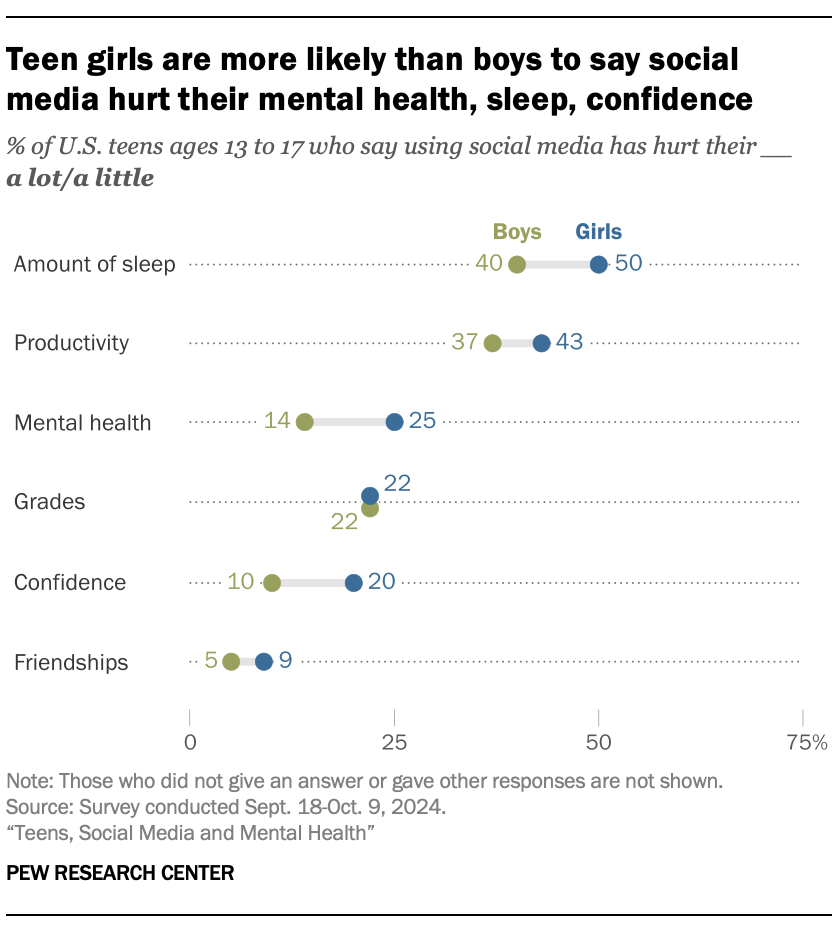
Teen girls stand out from boys in saying social media are harmful to their mental health. While 25% of girls say social media have hurt their mental health, that share drops to 14% among boys. Still, regardless of gender, the largest share says social media sites neither help nor hurt this.
At the same time, girls are more likely than boys to say the sites hurt the amount of sleep they get (50% vs. 40%), their confidence (20% vs. 10%) and friendships (9% vs. 5%).
Gender differences on social media’s impact on teens’ productivity or grades are not statistically significant.
There are no meaningful gender differences among teens who say social media help any of the six aspects we asked about.
Social media: Connections, creativity and drama
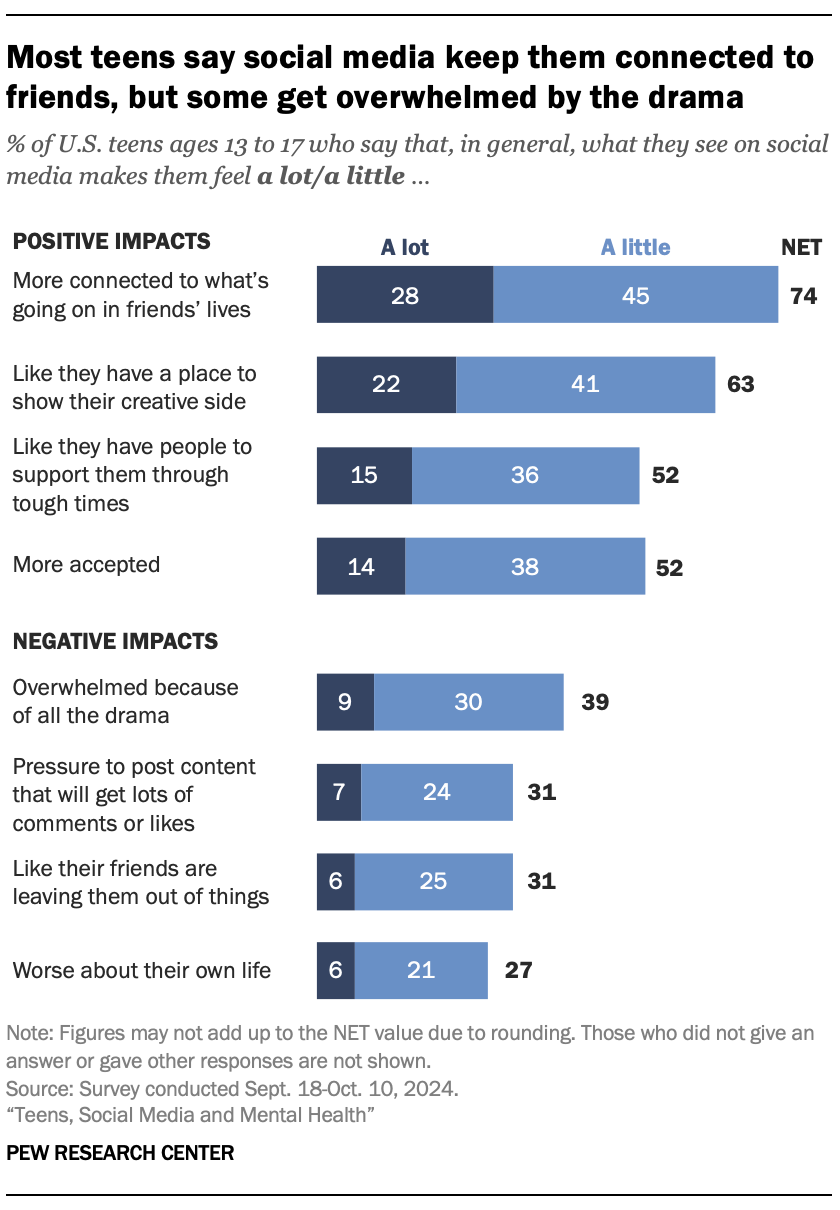
A majority of teens credit social media with forming connections and expressing their creativity. Roughly three-quarters of teens (74%) say what they see on social media makes them feel more connected to what’s going on in their friends’ lives. And 63% say social media platforms are a place they can show their creative side.
And about half – 52% each – say what they see on these sites makes them feel more accepted or as if they have people who will support them through tough times.
Even as teens have positive experiences on social media, they also encounter a less desirable side. About four-in-ten teens (39%) say social media make them feel overwhelmed by drama. Smaller shares say these platforms make them feel pressure to post popular content (31%), excluded by friends (31%) or worse about their own life (27%).
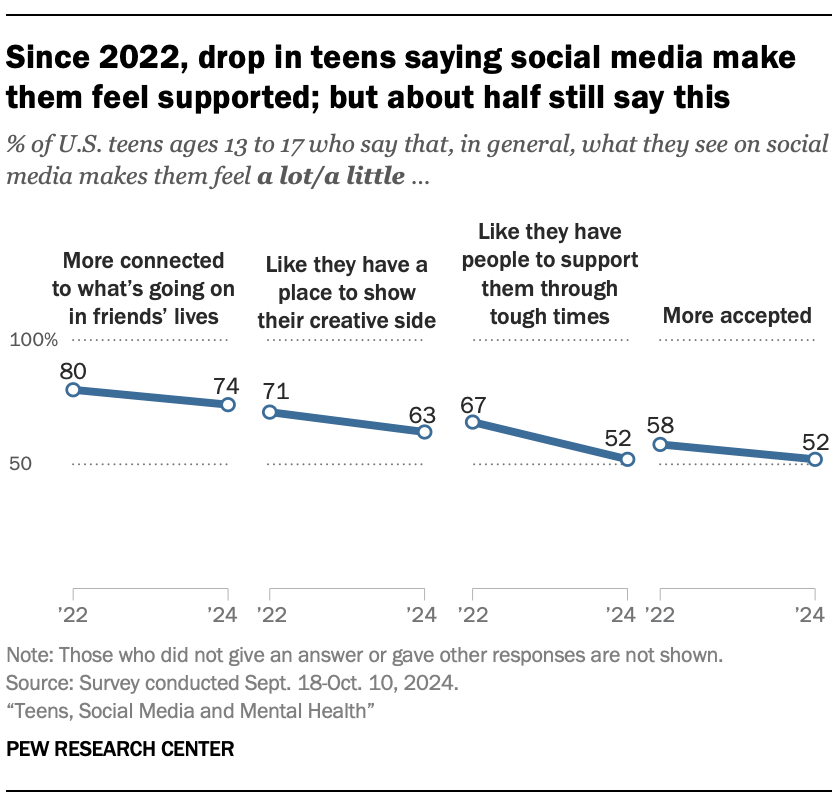
Fewer teens now credit social media as a support system. The share who say social media platforms make them feel like they have people who can support them through tough times has declined to 52% in 2024 from 67% in 2022.
Fewer teens in our current survey than in 2022 believe social media let them showcase their creativity, make them feel more connected with friends, or make them feel accepted. However, about half or more still acknowledge these platforms’ positive effects.
The shares of teens who cite having any of the four negative experiences with social media that we asked about have seen little to no change since 2022.
Teens’ experiences, by gender
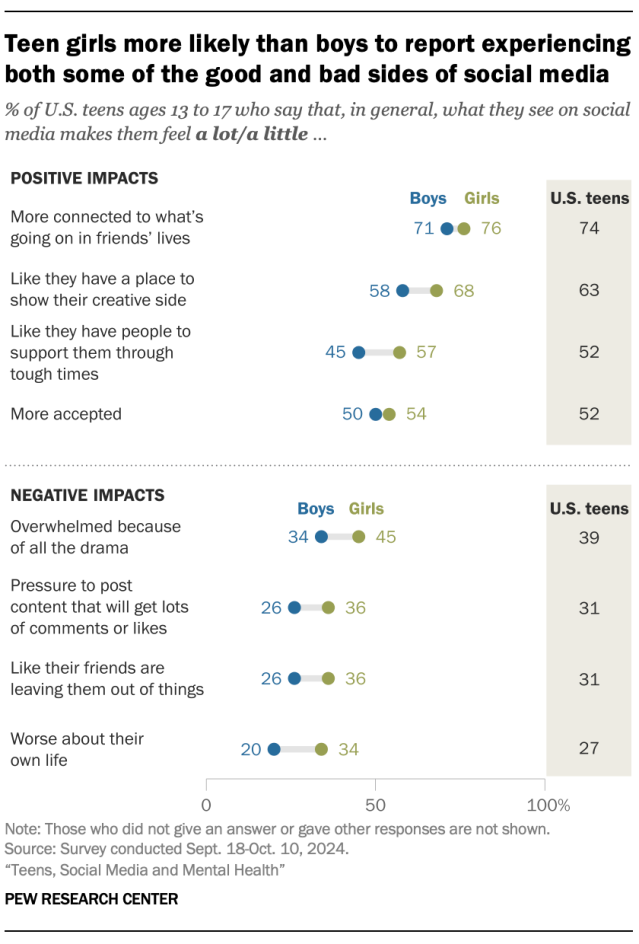
As was true with our previous survey, larger shares of girls than boys report having a more negative experience on social media. For example, 34% of teen girls say social media platforms make them feel worse about their own lives, compared with 20% of boys. This is consistent with our findings from 2022.
Girls are also more likely than boys to say social media make them feel overwhelmed because of drama (45% vs. 34%), pressure to post popular content (36% vs. 26%), or feel excluded by friends (36% vs. 26%).
Still, girls more often than boys report experiencing some of the positive sides of social media. Larger shares of teen girls than boys say these sites make them feel like they have people to support them (57% vs. 45%) and a place to show their creative side (68% vs. 58%).
Teens’ experiences, by race and ethnicity
There are only modest racial and ethnic differences in whether teens have these kinds of experiences on social media. However, there are differences in the degree to which they feel this way.

For instance, a larger share of Black teens than White and Hispanic teens say they feel a lot of support and acceptance from social media. One-quarter of Black teens say social media platforms make them feel much more accepted. Smaller shares of White (10%) or Hispanic (13%) teens say this.
Black teens (26%) are also more likely than White (12%) or Hispanic (15%) teens to say that what they see on social media makes them feel like they have a lot of support through tough times.
Additionally, 31% of Black teens say that what they see on the sites makes them feel a lot like they have a place to be creative, compared with 18% of White teens who say the same. Hispanic teens do not meaningfully differ from either group.
There are little to no racial and ethnic differences among teens who say social media make them feel overwhelmed by drama, pressures when posting, left out by friends, or worse about their own life.
Teens’ views on screen time and efforts to cut back
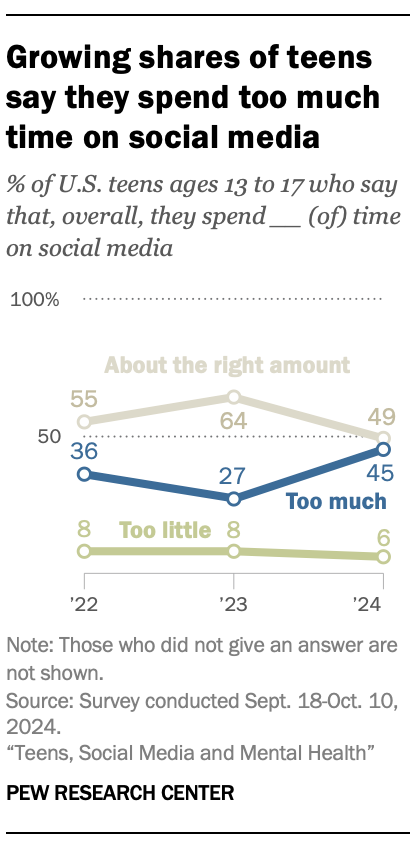
Parents have many concerns about their children’s use of social media, and screen time is at the top of their minds. Some legislators share these sentiments, proposing regulations to set time limits on app usage.
Teens themselves are more likely today than two years ago to describe their social media use as excessive. More than four-in-ten teens (45%) say they spend too much time on social media. This is up from 27% in 2023 and 36% in 2022.
The share of those who say they spend about the right amount of time on it has dropped to 49% in 2024 from 64% in 2023 and 55% in 2022.
The percentage of teens who say they spend too little time on social media has remained relatively constant over the past two years.
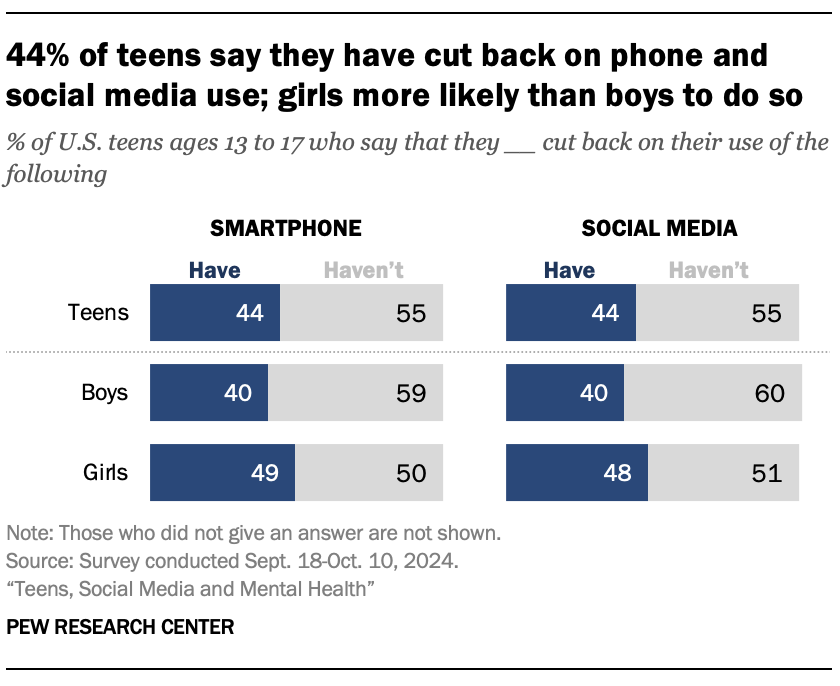
Some teens are cutting back on their social media use. We found that 44% of teens say they have cut back on using social media, and an identical share say the same for their smartphone use.
Both of these shares have increased since we asked this question in 2023. Then, 39% of teens said they cut back on social media, and 36% said the same about their phone use.
Still, more than half of teens (55% each) say they have not cut back on using smartphones and social media.
Teens’ experiences, by gender
Teen girls are more likely to say they’ve tried to reduce their screen time. While about half of girls say they have tried to cut back on social media and smartphone use, 40% of boys say the same for each.
Teens’ experiences, by their screen time
Teens who report spending too much time on social media are more likely to report cutting back on it. Roughly half of this group (49%) say they have attempted to do this. However, this number drops to 41% when looking at those who are satisfied with the amount of time they spend on social media.




